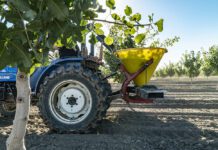Well, well, well. Two years in a row of above-average rainfall? “Toto, I don’t think we are in Kansas anymore…” What is this world coming to? We’ve now lived through the next coming ice age, global warming, rising seas, melting polar ice caps (the south, and then the north), a new lake in California (that isn’t really new), climate change and now global climate dynamics, all in 30 years. Pretty impressive on you growers to still be making it happen with all these factors moving the goal posts. The true predictable integer in this equation is that growers are dynamic. And we whole heartedly thank you for that. In fact, the entire world thanks you for that. You people must be nuts!
Speaking of dynamics, actual nuts that grow on trees, unlike legumes on a bush that call themselves “pea”nuts, are very dynamic. Right now, that statement is more true than any other time of the year.
We’ve finished it and are sizing nicely in our almond orchards, while pistachios and walnuts are probably winding down as this article is published.
Cell Division
Typically, science tells us that nuts have about a month of hyperactive cell division. At that time, my favorite nutrient, calcium, is critical in making that happen. Of course, we have to have all 17 of the outsiders dialed in while Mother Nature provides us those other three in carbon, hydrogen and oxygen. But limited supplies of ionic calcium is critical for all those cells to keep dividing and remain strong. Calcium ions (Ca2+) appear to participate in the regulation of several aspects of cell division.
Evidence is accumulating that transients or local gradients in the (Ca2+) contribute to different events including nuclear envelope breakdown and reformation, cleavage furrow formation and growth, and cell plate formation. By the early to mid-70s, the ideas were in the air, and thus well before the actual documentation of the [Ca2+], many scientists working on different aspects of plant growth and development were coming to recognize the potential importance of Ca2+ as an intracellular signaling agent” (Hepler 2005).
The problem with Ca is while it may be abundant in the soil, it is rarely significantly soluble enough to provide adequate levels at a consistent quantity. The soil pH, biology and moisture levels play a key role in making that happen. The programs I design for my growers always push many applications throughout the season of soluble Ca, chelators, complexors and biology to ensure this happens.
“Keep it Coming”
“While early work concentrated on the role of Ca as a nutrient and structural component, it has become more and more clear now that the main function of Ca lies in its ability to serve as a second messenger in a vast variety of physiological, developmental and stress-related processes, and indeed some of the observed effects of Ca application might also be connected to this function rather than being purely structural” (Thor 2019).
Here’s the other problem with Ca, unlike N: It is immobile in the plant once it finds a home. It does not relocate from old tissue to new tissue and growing points. We need a constant supply to ensure optimal health and yields. It is a secondary messenger, telling the plant to elicit responses to pathogens and stress. While it’s locked up in structural components of plants as they grow and repair, it can’t help with the secondary messenger duties or new structures. To me, this means, “Keep it coming!”
How about some more love? Elemental ionic Ca has two charges. It will lock on to soil and kick off two sodium molecules, cleaning up the ground as water percolates. It is also a larger element and has a larger hydration radius. Ca helps wedge the ground open on a microscopic level and allows water to flow better. If you don’t apply a soluble Ca, you can acidify your water and break much of that Ca locked up as carbonates, bicarbonates, gypsum and even to some extent calcium phosphate to achieve some of that effect. You can also increase your soil health and functionality by improving your soil biology. Add some carbon sources, active biology, inactive residues from previous biological reactions and compost (in the form of actualv compost or teas.) Increase your C:N ratio if is not ideal at about 10:1
I harp on getting your Ca right because it is such an important element. There are so many things we need to do right to make it available and effective. With the cleaner and more abundant water, if our government allows it to be (?), we should be able to make more of this element available and instrumental in cleaning our soils and creating heavier crops. More cells, healthier trees and heavier nuts means more money in our pockets at the end of the season. Healthier trees should equate to less crop protection products and less passes through our fields. That means less compaction. Better water use efficiency can translate into less electrical or diesel expenses to pump water. It all adds up. Effect your own change, change your practices a bit and put some more change in your pocket.
References
Hepler, Peter K. “Calcium: A Central Regulator of Plant Growth and Development,” The Plant Cell, Academic.oup.com/plcell/article/17/8/2142/6114599, August 8, 2005
Thor, Katherine. “Calcium, Nutrient and Messenger”, Frontiers, www.frontiers.org/journalists/plnt-science/articles/10.3389/fpls, April 24, 2019












